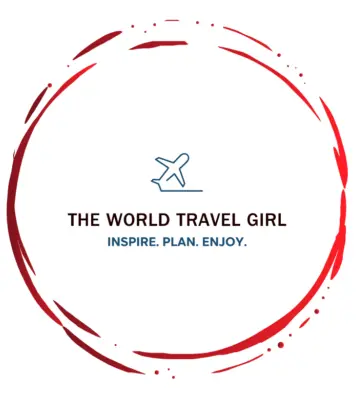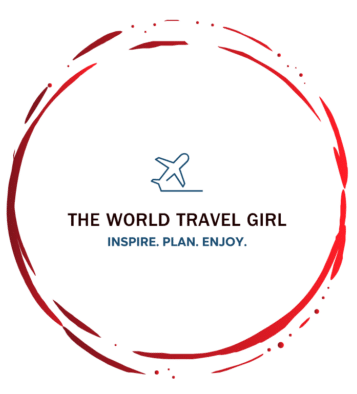Beginners Guide to Kilimanjaro: A First-Timer’s Experience
Situated in northern Tanzania, Mount Kilimanjaro stands as Africa’s highest peak situated 150 miles (324 kms) from the awe-inspiring Serengeti National Park in Tanzania. Although I didn’t have the opportunity to climb it during my trip to Tanzania, my friend Aliya did. This Beginners Guide to Kilimanjaro will provide her firsthand experience of climbing Mount Kilimanjaro.
Disclaimer: This post may include affiliate links. If you click one of them, I may receive a small commission at no extra cost to you.
Don’t have time to read the whole article but want to check out the exact route? This 7 Day Machame Route is what she did. Enter referral code THEWORLDTRAVELGIRL to receive a discount when booking or inquiring.
Aliya Rashid, 31 years old, weighing around 100 lbs, with an intermediate fitness level, climbed Kilimanjaro in February of 2024. The following will be a blend of information, practical advice and her personal insights so you will have everything you need to know if you want to summit Kilimanjaro. As stated, this is her experience and what she learned. Aliya is not an expert, so take this information as her point of view and what she learned along the way, from training recommendations to acclimatization strategies to minimize altitude sickness.
I will start with some basic information on Mount Kilimanjaro before I get into the questions I asked her. This guide will provide her detailed and honest perspective as well as her feelings of what she went through on her amazing journey. I hope you enjoy my interview with Aliya.
Facts About Kilimanjaro:
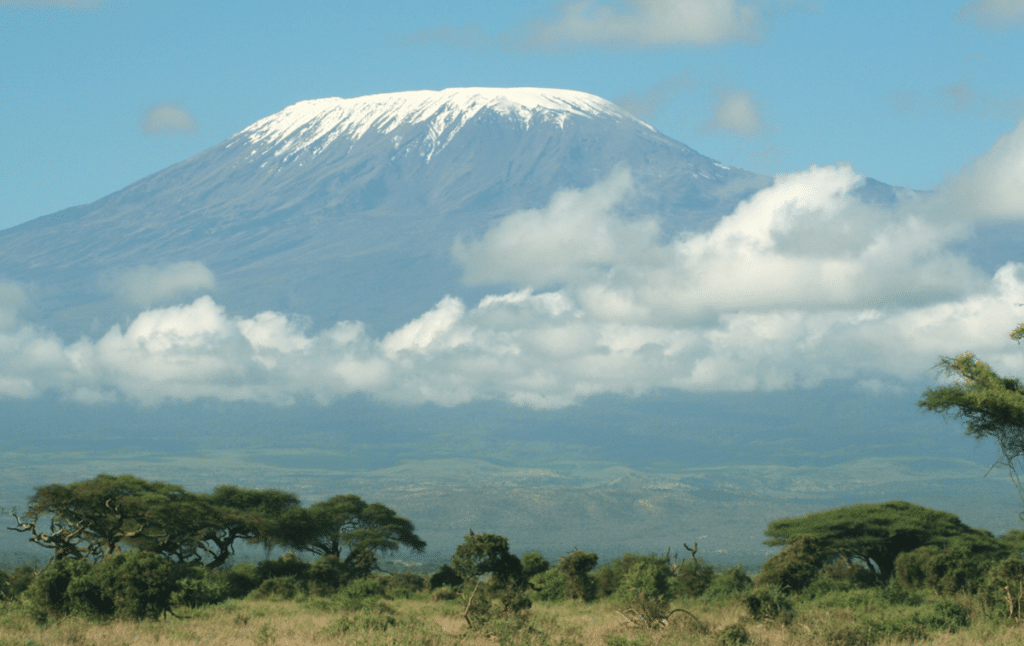
What are the weather conditions like on Kilimanjaro?
Ascending Kilimanjaro involves passing through five different zones: bushland/cultivated, rainforest, heath/moorland, alpine desert, and arctic, with each zone exhibiting distinct weather and terrain characteristics. The temperatures range from hot and humid at lower elevations to cold and dry at higher elevations, ultimately leading to the extreme conditions of the summit. You will learn more about that later in this guide.
What are the routes to Kilimanjaro summit?
Below you will find the most common routes that are taken on Kilimanjaro. There are two unofficial routes, the Umbwe route and Alternative Lemosho Route (Northern Circuit), that are also available
| Route | Distance (ascent) | Distance (decent) | Altitude Gain | Total Duration |
| Machame (aka Whiskey Route) | 40.16 kms | 20.6 kms (Mweka) | 4, 255 metres (14,051 feet) | 6-7 days |
| Marangu (aka Coca Cola Route) | 36.75 kms | 36.75 kms (Marangu) | 4,052 metres (13, 384 feet) | 5-7 days |
| Lemosho | 46.26 kms | 20.6 kms (Mweka) | 3,795 metres (12,541 ft) | 6-9 days |
| Shira | 46.26 kms | 20.6 kms (Mweka) | 2,481 metres (8,231 ft) | 6-9 days |
| Rongai | 37.65 kms | 36.75 kms (Marangu) | 3,945 metres (13,033 ft) | 5-7 days |
What made you decide to climb Kilimanjaro?
My dad was born and raised in Tanzania and always talked about it. I told myself if I ever had the opportunity, then I would do it. I was in Kenya and Tanzania on a Global Health Rotation, so I decided to just do it. I booked it and once I signed up, I was committed to doing it.
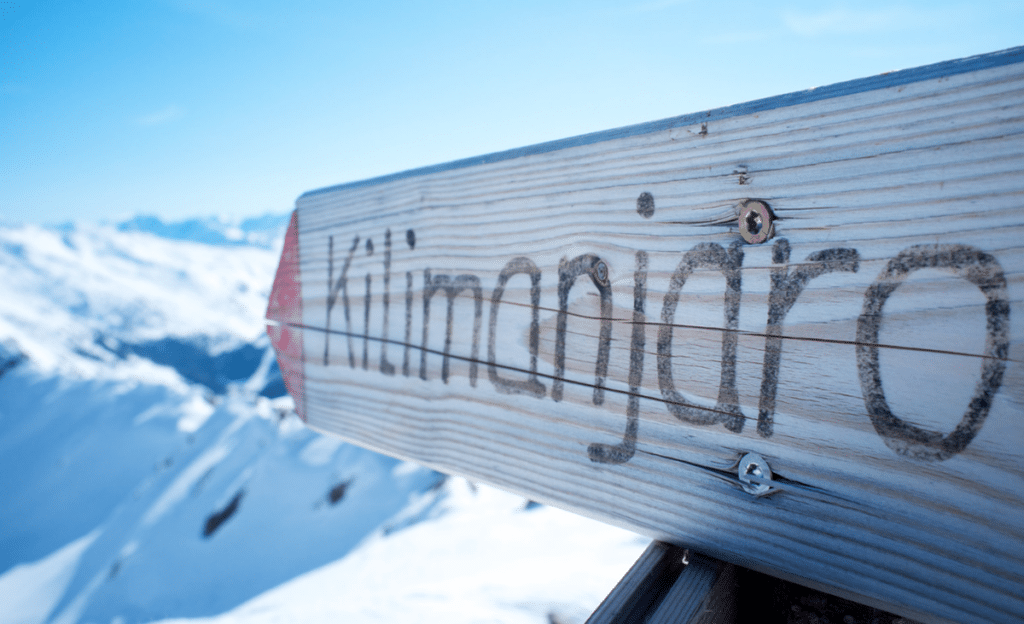
What company did you book with?
I booked with Cloud Safaris, affiliated with Zara Tours. Zara tours organized the guides, porters and chefs. Cloud Safari coordinated and booked the flights and hotels. They provided information on the requirements including travel insurance, packing lists, as well as separate adventure insurance. There was 2 Canadian guys with me on the trek.
The specific route Aliya did was the 7-day Machame Route.
Interested in booking this? I have a great deal for you! Through my travel planning services, I am partnered with CloudSafaris and you can get a discount with your booking. Visit the link above or Cloud Safari Trips and enter the referral code: THEWORLDTRAVELGIRL to receive a $100 discount on your booking.
Cloud Safari will not charge you right away if you book online. They will be in touch to review details and plans before anything gets confirmed.
Approximately how much did it cost?
Not including flights, it was around $3000 US for 7 days + $450 in tips for the porters at the end of the hike. It is recommended to tip around $100 per porter/guide and each hiker has 3-4 people supporting them.
Pricing is dependent on the route, duration and add-ons. I know people that have paid $5,000-$7,000 for their climb. The Marangu route is a bit cheaper, probably because there are less requirements for a porter to set up tents, as you sleep in huts and because it is shorter route.
TIP: If you have flexibility, book a group trek as opposed to a private trek, to save money being in a larger group.
Is climbing Kilimanjaro hard?
The answer resonates with a resounding “yes.” The effects of altitude and lack of oxygen is key; it’s the main reason many people struggle on Kilimanjaro, where success rates hover around 50%. While the trails aren’t typically steep, dealing with altitude is the main challenge.
Can beginners climb Kilimanjaro?
I think it depends on how active you are. I don’t think you have to be really fit, but you do have to have some sort of consistent physical activity or hiking under your belt. It does require some level of fitness and cardio.
How did you prepare to summit Kilimanjaro?
Preparing to summit Kilimanjaro requires more than just physical readiness; it involves mental preparation and understanding the risks. It’s not about the summit, it’s about the climb. It’s about what you learn on the way there if you can stay in the right headspace.
I work over 70 hours a week in my medical residency. I didn’t have time to specifically train for it. I run 5 kms every morning and do workout classes of yoga with weights or core power 6 days a week. For 6 months prior I would not use the elevator at work and would take the stairs as much as possible. I don’t live near mountains so this was the next best thing.
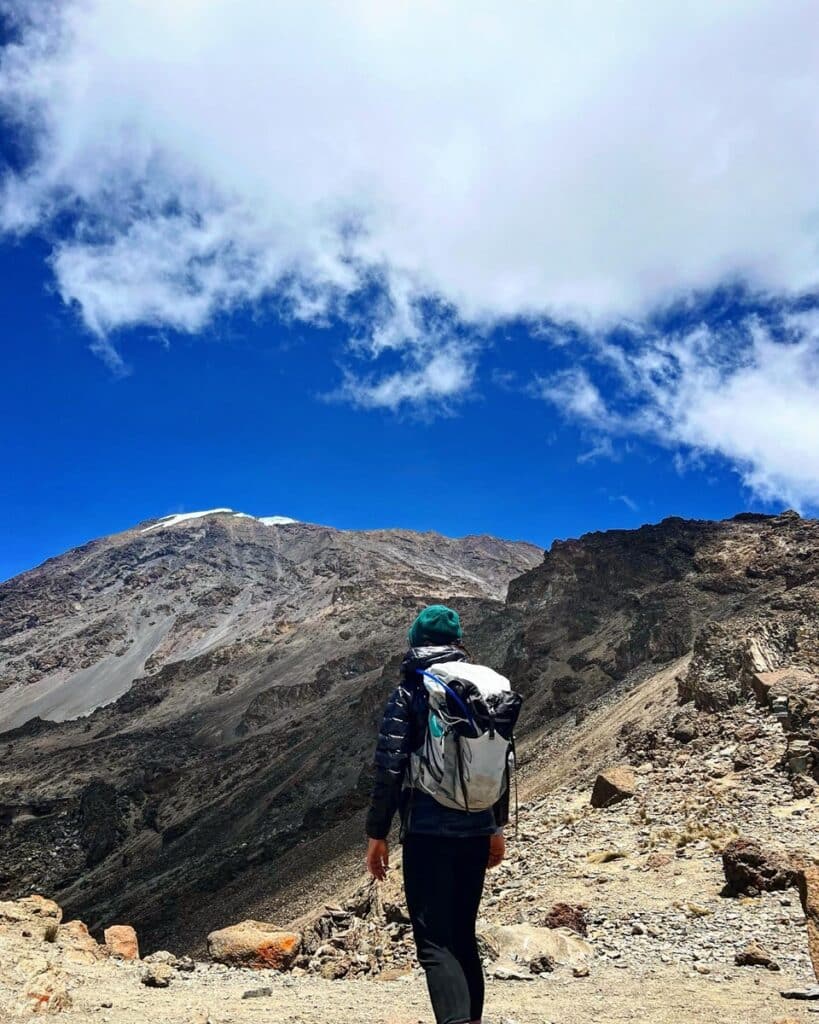
What trail/route did you take? Do you think it was the best route for a beginner?
I did the Machame route. It is a longer route so you have more time to adjust to the altitude. “Trek High and Sleep Low”. You should be more physically fit for this route. They do say this route is the highest success route to the summit. I would not recommend this route for beginners as it is one of the harder ones.
The Marangu route is the best for beginners. You stay in huts, not tents. It is shorter but you have a higher risk of altitude sickness. It is easier than the other routes.
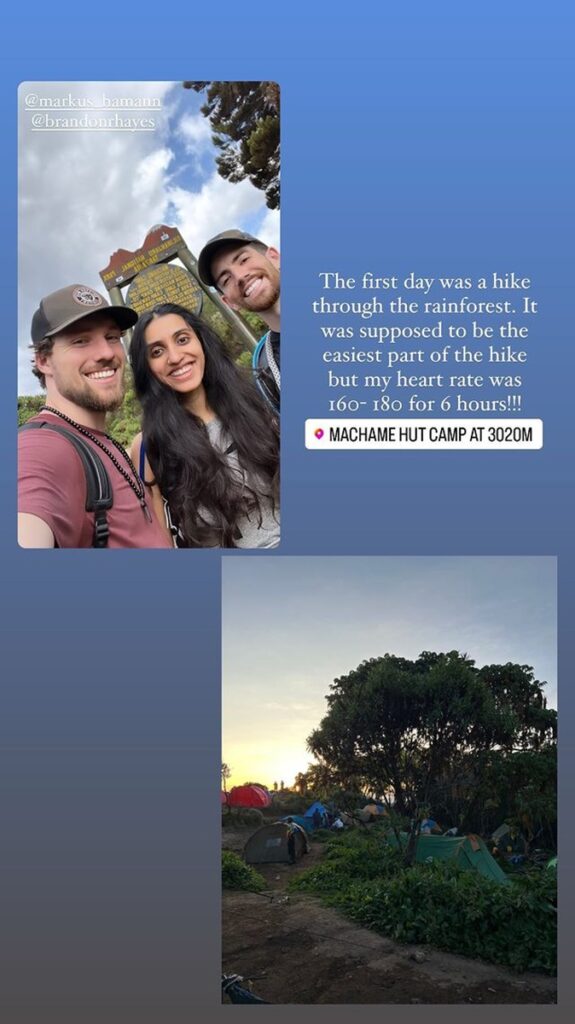
What was the weather like? How cold was it at the summit of Kilimanjaro?
For the most part, the weather was fine along the way and we had no rain. February is usually the best time of year to traverse Mount Kilimanjaro. However, things changed drastically when we hit summit night. It was an unusual storm that hit that night. There were crazy winds from 70-100 kms. Things were literally blowing away, including me! They had to weigh down my backpack because I was so light and was lifting up.
To add to that, there was a sandstorm and ice storm. It is usually below zero at the top with the windchill and ice. But this was an exception. The people going up the next night were unable to ascend to the summit because of the weather.
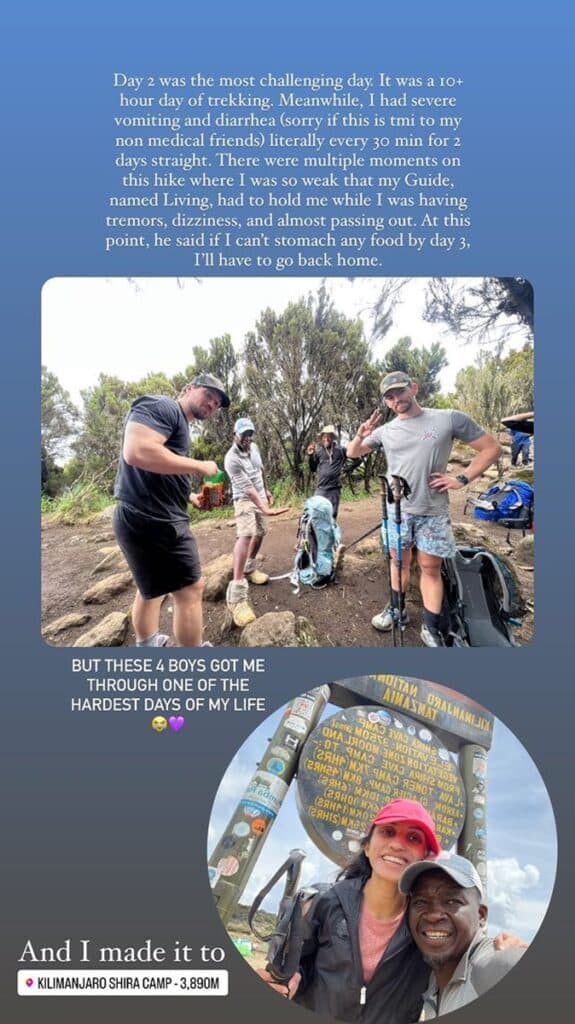
Tell me about the camps. What were they like?
First, it took 5 days to go up and 2 days to come down. The camps in order were:
Day 1: Machame
Day 2: Shira
Day 3: Barranco – this is acclimatization day where they decide if you can keep going or not
Day 4: Karanga
Day 5: Barafu – Base camp right before you summit
Day 6: Mweka Camp (descent)
Day 7: Mweka Gate
I hear that Barranco Wall can be challenging. Did you climb it? How was it?
Barranco wall is part of all routes except Marangu. Rumors say it was challenging but it’s not. For me, it was the funnest part of the trip. Of course this is dependent on your strength and body composition. I didn’t realize how much I loved climbing until I did the wall. The guys I was with didn’t enjoy it as much.
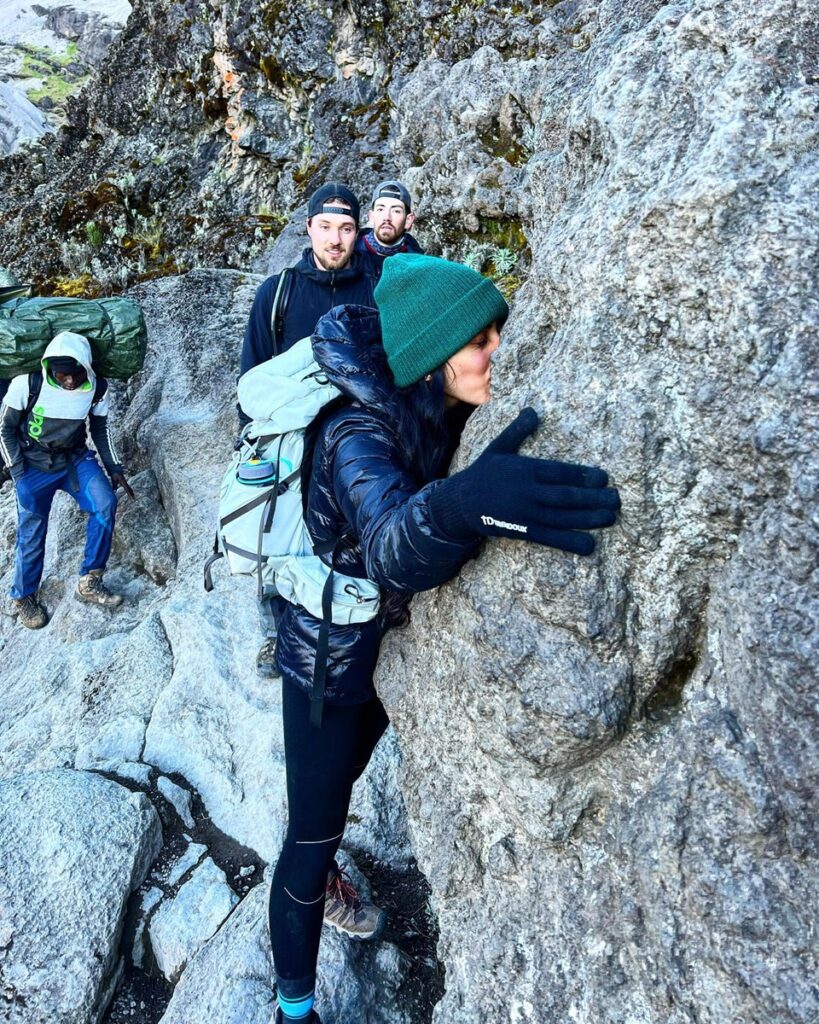
Tell me what a typical day looked like. How long did you climb for? How many breaks?
A typical day started around 5:00 or 6:00am. We would start before the sun rose to get an early start and avoid the heat that came as the day progressed. We usually hiked about 6 hours a day, with the second day being the longest around 9-10 hours. After breakfast we would get going and not stop for meals, but just snack along the way. The sooner we go hiking for the day, the sooner we can get to the tent and then relax.
What do Kilimanjaro porters do?
These guys are amazing! They carry 50L-70L duffel bags with all my clothing and personal stuff, the tents, portable toilets, food, equipment and supplies needed for your hike. They set up the tents and cook the food as well.
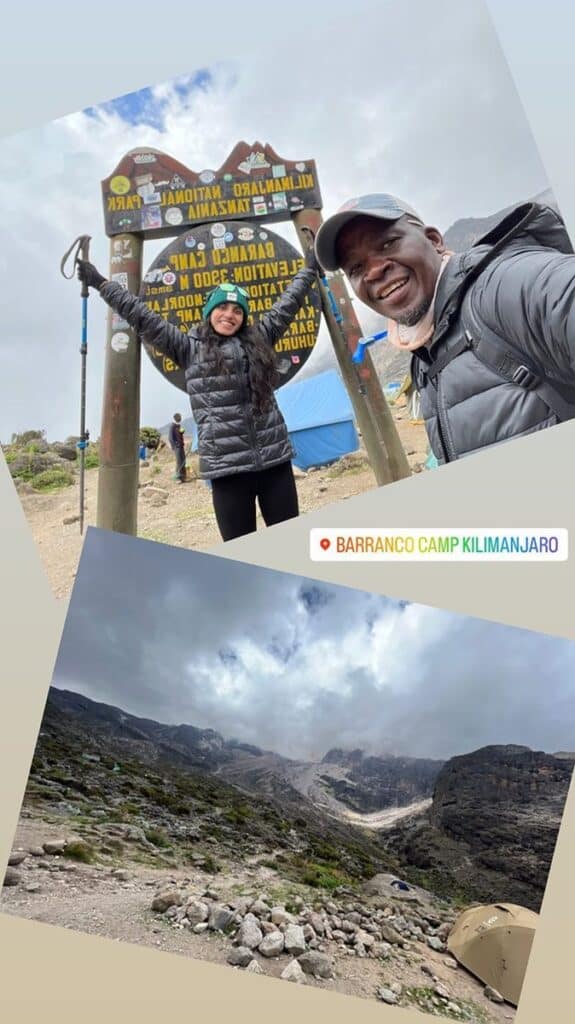
What did you sleep in on Kilimanjaro?
We slept in tents. Porters set up the tents for you. I recommend paying the extra for the add-on to have a private tent. This is especially useful if you are sick, like I was, and have to constantly leave the tent. The tents are quite big so you have room to lay out your stuff and be organized.
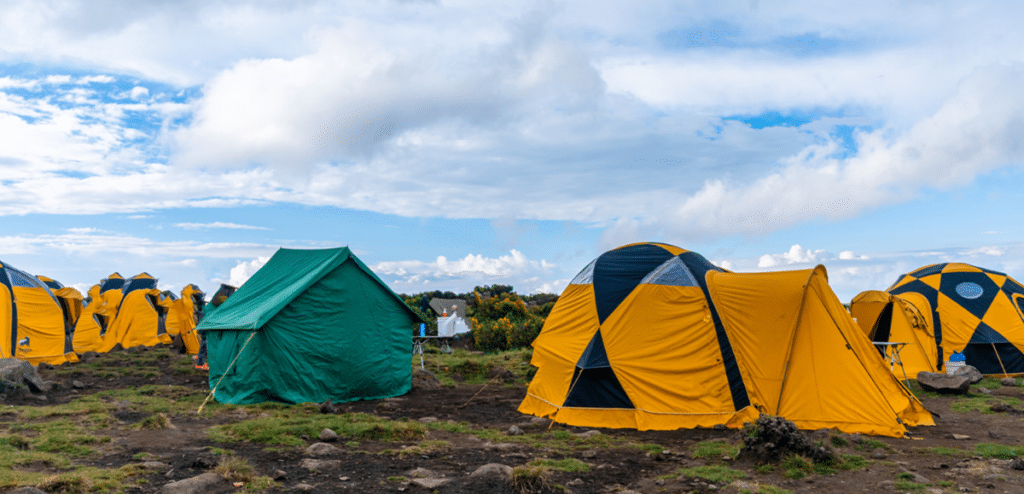
Where do you go to the toilet on Kilimanjaro?
There are public bathrooms at each camp site, though I do not recommend them for girls, as they are not very clean. I paid extra to have a private portable toilet, which the porters carry for you. They set up the toilet, dig a hole and once you are done, they use water to clean it. You pretty much have something to sit on within a private tent. This is why I tipped a little bit more at the end of the trip.
Was there a phone signal on Kilimanjaro?
Yes! There was a connection in some areas. You would see all the porters bunched up in an area so you knew there was a signal there.
What did you eat for your meals?
The meals were amazing! I later learned that the porters run all the way back down to base camp every single day to bring back fresh food for the meals. We had mangos, bananas, popcorn (snack after hikes), coffee, tea and hot water. As we got closer to top, the food is limited as to what they can cook because of the lack of oxygen, so we ended up sticking to our snacks.
Did you have Altitude sickness?
This was one of the worst parts of my trip. For the first two days I was extremely sick with nausea, vomiting and diarrhea. They had to figure out what was wrong because this shouldn’t be happening for this long. I was taking Malarone – for malaria and Diamox for altitude sickness. My guide advised me that Malarone will make you sick at this altitude and plus there are no mosquitos up there.. Diamox could also be doing the GI distress so they recommended stopping both.
When I woke up the next day I felt so much better. I didn’t take anything the rest of the trip, except for one brief period of time approaching the Summit. For the guys they were getting sicker and finding it harder to breathe.
TIP: Spend a few days in Moshi before your trek to start acclimatizing to the altitude. It doesn’t matter how fit you are, altitude sickness hits everyone different.
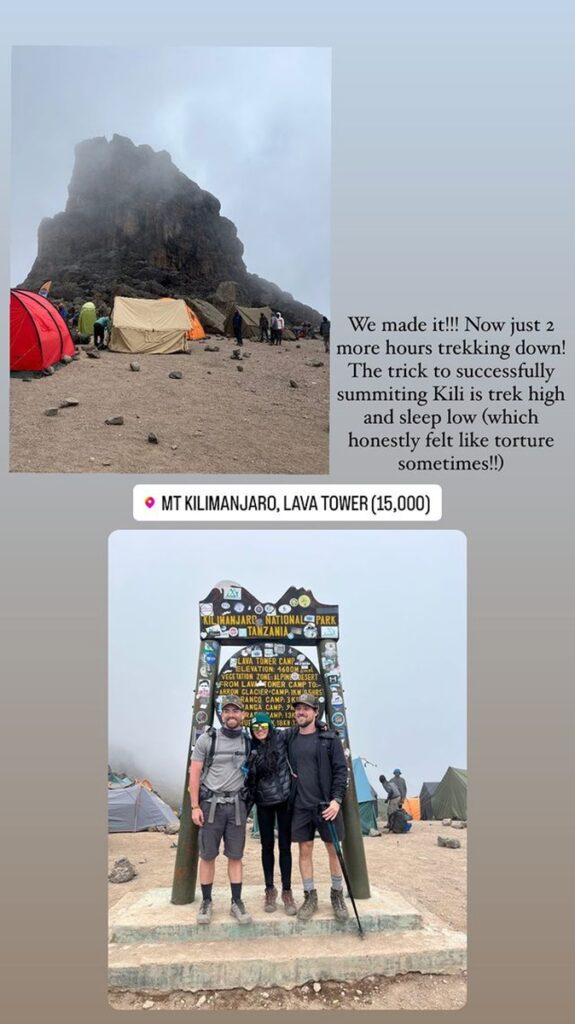
Tell me about Summit Night to Uhuru Peak.
Summit Night starts at Barafu Camp. It started with about 4 hours of hiking in the morning. Then you rest and relax before starting the hike at midnight. The reason the hike takes place through the night is because they want to make it to the top before the sun starts rising because the ice/glaciers can start melting, so this way it is safer.
Remember that we had abnormal, horrible weather conditions. Because of this, the tents were blown down, so we had nowhere to eat or drink. We did the trek to the summit without food. When I reached the first sign, I was in a daze. The next 30 minutes to the peak was a steep elevation gain, so I took a Diamox just to get to the top as I was having trouble breathing. Unfortunately it did cause GI issues for me again, but I had to do it.
The best way to treat altitude sickness is to descend in altitude. For 5 hours we could barely see because of the ice storm. The winds were so bad that we didn’t stop at base camp for a break and just kept hiking down for 12 hours.
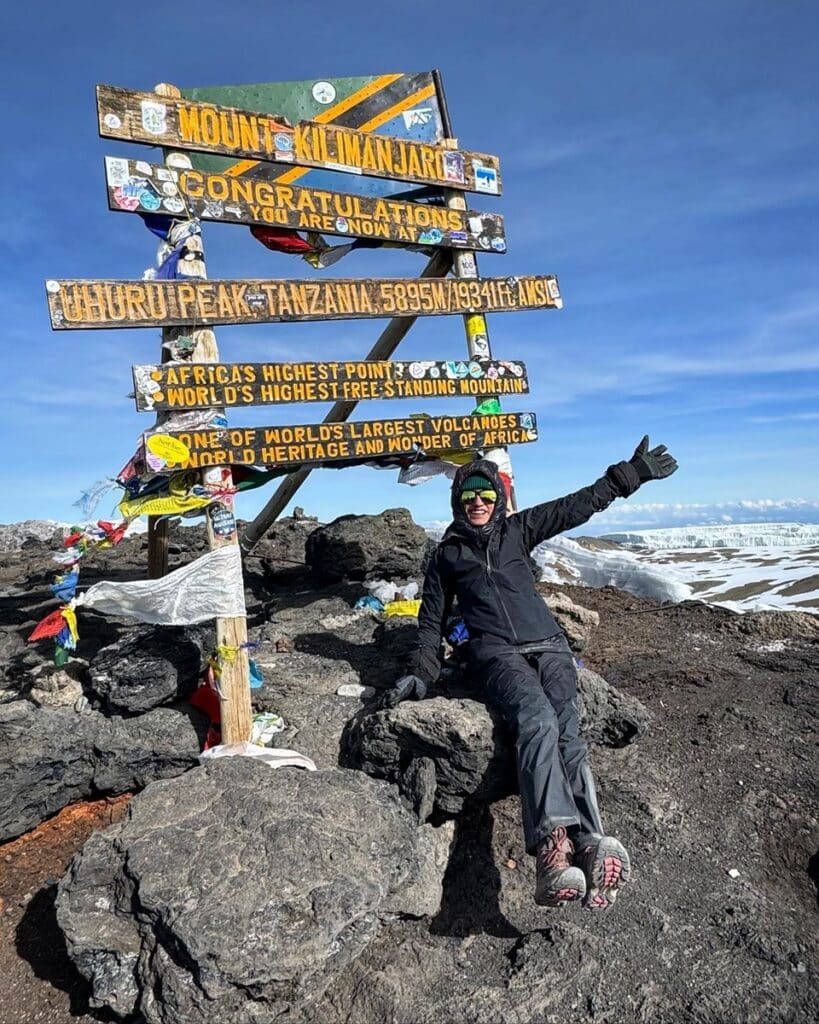
What was the hardest part of Kilimanjaro?
Aside from being sick and summit night, it is completely a mental thing. You just don’t know how your health is going to be. It’s mind over matter. How badly do you want to get to the top?
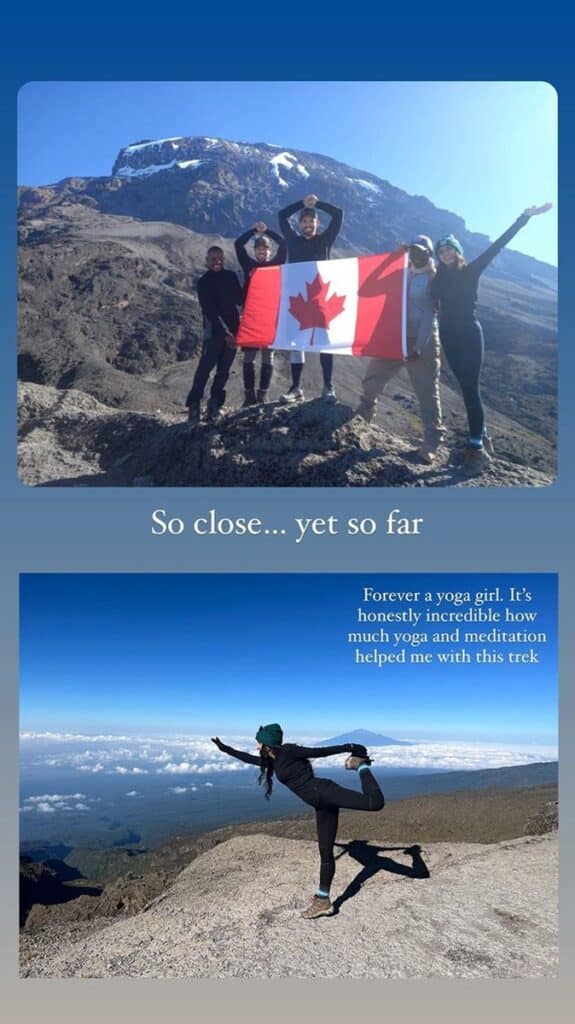
What surprised you? Did you learn anything about yourself?
It wasn’t as physically challenging as I thought it would be. Climbing the Barranco Wall was one of the best parts of my trip.
Like I said, it was all mental. Being able to overcome what is thrown at you – being sick, bad weather, adapting to people and surroundings. You can’t really prepare for it. It was nice to not go with people you know and experience it with people who are like minded but don’t know anything about you.
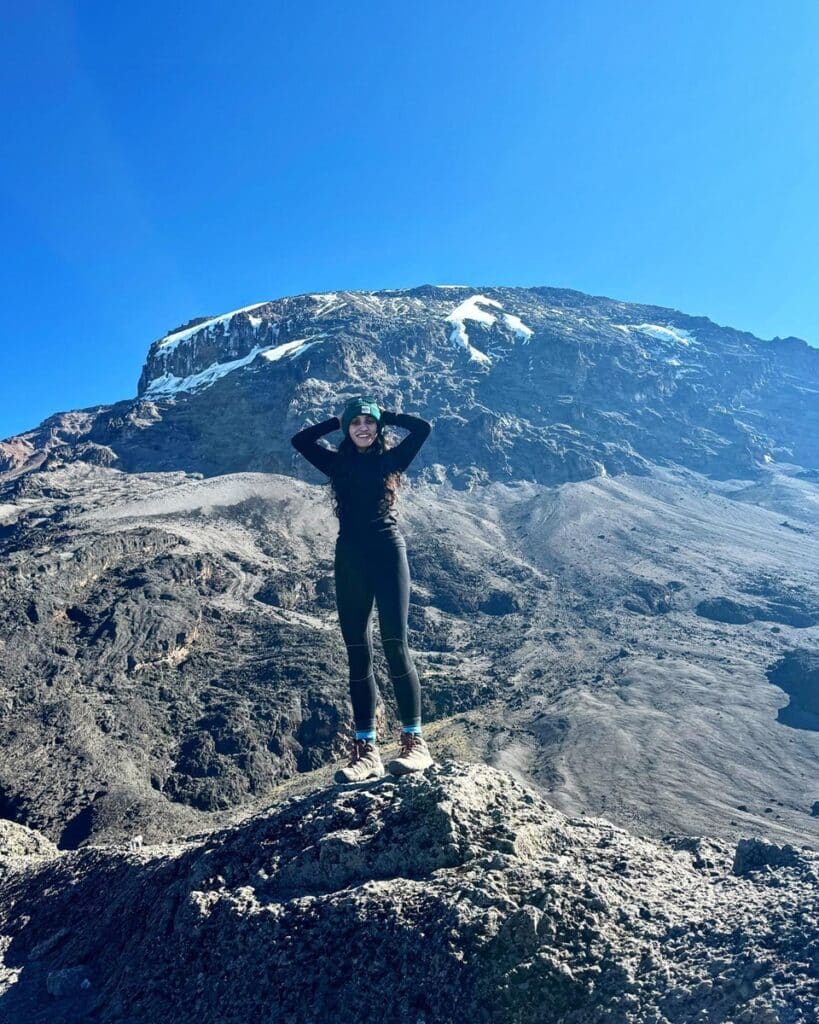
What did you wear for the trek?
What medications do you recommend bringing?
NOTE – porters carry antibiotics for GI issues, sutures, bandages etc. They have all the medical supplies that are the best, so it’s not necessary to bring them.
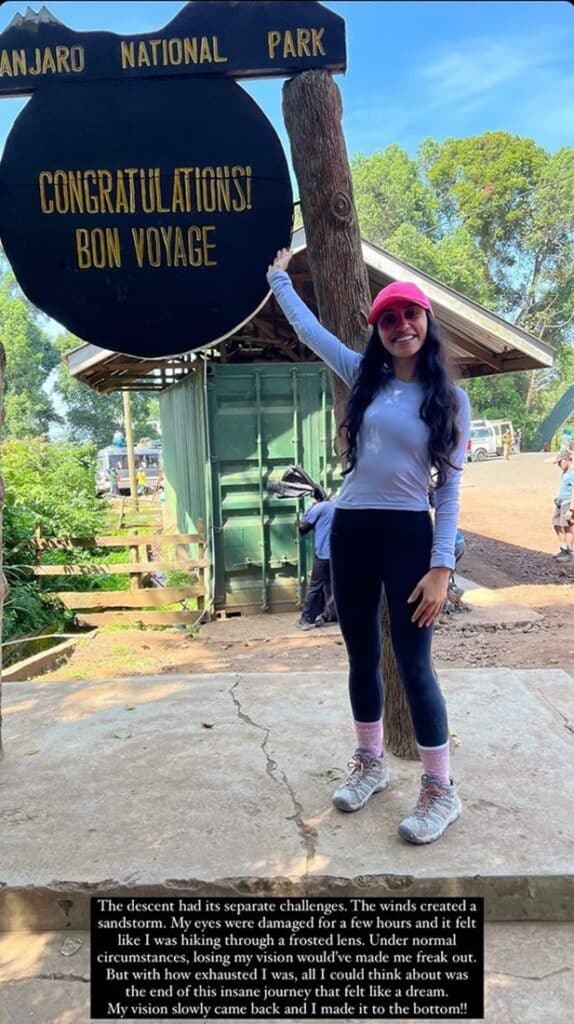
Did you see any animals?
Due to the high altitude, I never saw any animals during the trek. If you want to see wildlife, you are best to add on a safari to one of the national parks in Tanzania like the Serengeti, Ngorongoro Crater, Lake Manyara or Nyerere National Park.
What did you eat when you were done?
I couldn’t wait to have a greasy pizza and all the calories I could handle!
Did you visit anywhere else in Tanzania when you were done?
I went to Zanzibar for a few days of relaxation and rest before heading to Dar es Salaam for a week of work.
Essentials for Visiting Tanzania
Ensure you have your passport, visa, and any vaccinations that are required to visit Tanzania.
Visiting a foreign country can always pose some risks, as you never know what could happen. Having travel insurance is a must. I recommend SafetyWing for coverage while traveling including adventure travel insurance.
Data connections are available throughout Tanzania, even in the middle on parts of Kilimanjaro! However, if you want to ensure you have a data connection, then I recommend getting an eSIM from Airalo. Very reliable and inexpensive!
Final Thoughts
This Beginners Guide to Kilimanjaro is full of useful insights and information from my friend Aliya, who took on the mental and physical challenge of reaching the summit. Through many challenges along the way, she discovered herself and her capabilities in many ways. I thank her for the opportunity to share her experience with fellow like minded adventure seekers.
If you enjoyed my post, follow me on social media or subscribe to my newsletter below, so you can stay connected on future posts, trips, tips and more.
